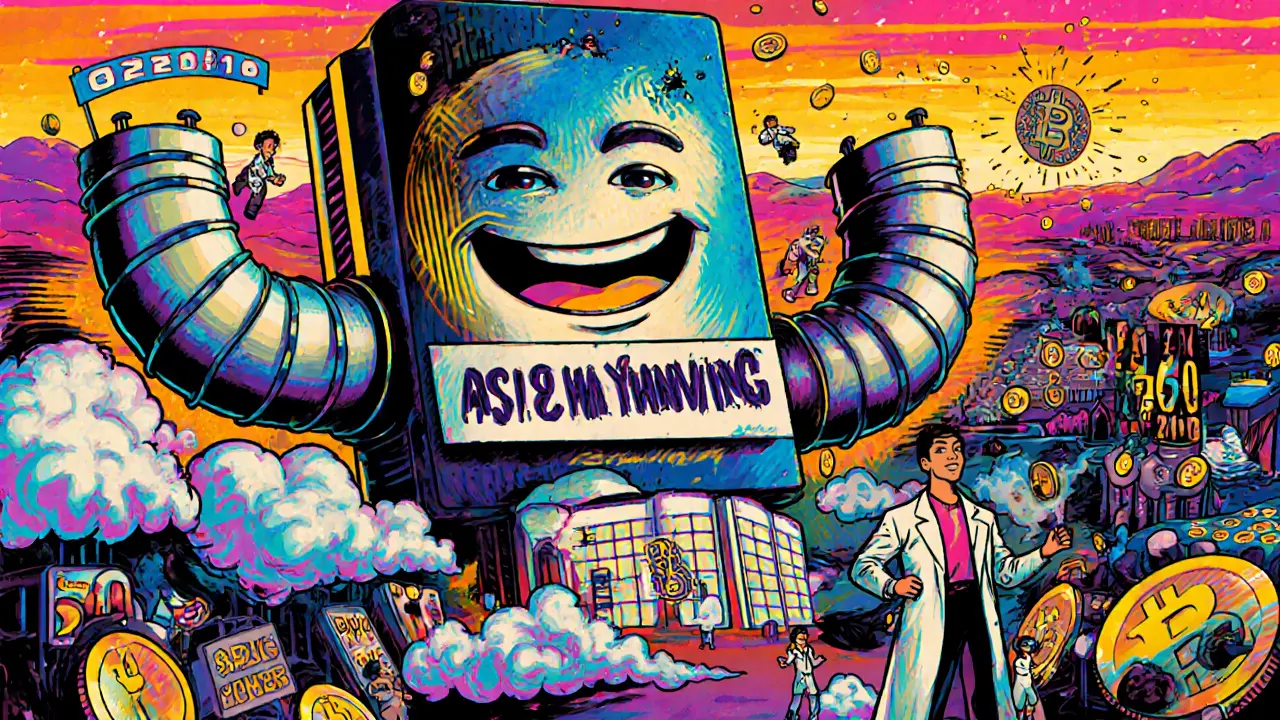Bitcoin Mining Profitability Calculator
When you hear someone say the Bitcoin network has a hash rate of 690 exahashes per second, what does that actually mean for your wallet? If you’re thinking about mining cryptocurrency, you need to understand one thing: hash rate isn’t just a technical number - it’s the heartbeat of profitability. And right now, that heartbeat is racing faster than ever.
What Is Hash Rate, Really?
Hash rate measures how many calculations a mining rig can perform per second to solve the cryptographic puzzles that secure blockchain networks. Think of it like a lottery where every hash is a ticket. The more tickets you buy, the higher your chance of winning the block reward. But here’s the catch - everyone else is buying tickets too. As of October 2024, Bitcoin’s global hash rate hit 690 EH/s. That’s 690 quintillion calculations every second. To put that in perspective, in 2019, the network ran at just 5.25 EH/s. In five years, it grew over 13,000%. That’s not progress - it’s an arms race. This isn’t about speed for speed’s sake. Higher hash rate means more security. The more computational power locked into the network, the harder it is for anyone to manipulate transactions or double-spend coins. But for miners, it’s also a death spiral. As more machines join, the difficulty adjusts upward - making each hash less valuable.Why Profitability Isn’t About Hash Rate Alone
You might assume that if you buy the most powerful miner, you’ll make money. That’s a myth. Profitability isn’t about raw power - it’s about efficiency, cost, and timing. Take the AntMiner S21e XP Hyd. It boasts 860 TH/s and uses 11,180 watts. Sounds impressive? It costs $5,999. At $0.12/kWh electricity (average U.S. commercial rate), you’ll spend over $11,000 a year just on power. Even with daily earnings of $39, you’re looking at a payback period longer than two years - if the price doesn’t drop. The real game-changer? Electricity cost. Miners in places like Iceland, where geothermal power runs at $0.03/kWh, make 3x more profit than those in Texas or New York. Nic Carter of Castle Island Ventures found that 18.7% of Bitcoin’s hash rate now comes from stranded energy - flared gas, excess hydro, or off-grid solar. These miners have an 11.3% cost advantage over grid-powered ones. And then there’s the halving. On April 20, 2024, Bitcoin’s block reward dropped from 6.25 BTC to 3.125 BTC. Overnight, miner revenue halved. The network hash rate plunged 19.3% as unprofitable rigs shut down. Within weeks, it recovered - but only because the survivors were the ones with the lowest operating costs.ASIC vs GPU vs CPU: The Hardware Reality
Not all miners are created equal. The hardware you choose determines whether you break even or go broke. - ASIC miners (like Bitmain’s S21e XP Hyd) dominate Bitcoin mining. They’re designed for SHA-256 algorithms and are 10,000x more efficient than GPUs. But they’re expensive, noisy, and useless for anything else. One unit can hit 85 dB - louder than a jackhammer. You need industrial space, not a garage. - GPUs (like the NVIDIA RTX 4090) are for altcoins like Ethereum Classic or Ravencoin. They’re flexible. You can switch coins if one becomes unprofitable. But they’re slow. The RTX 4090 earns $0.50/day on Bitcoin. That’s 78x less than an ASIC. And you’re still paying for power, cooling, and wear. - CPUs? Forget it. Even the AMD Threadripper 3990X only makes $1.16/day. For the same $5,000 you’d spend on an ASIC, you could buy 4,000 of these CPUs and still lose money. The numbers don’t lie. ASICs control 99.8% of Bitcoin’s hash rate. GPUs hold 87% of Ethereum Classic’s. There’s no middle ground. If you’re mining Bitcoin, you’re either in the ASIC game or you’re not playing at all.
Profitability Tools - And Why They Lie
There are dozens of calculators out there: NiceHash, WhatToMine, ASIC Miner Value, Jason Blevins’ tool. They all give you different answers. Why? NiceHash shows the S21e XP Hyd earning $39.11/day. But real users on Reddit report $34.45. Why the gap? Manufacturer specs are ideal. Real-world conditions aren’t. Dust buildup, voltage fluctuations, ambient heat - they all eat into efficiency. One miner found his S21e XP Hyd used 8.4% more power than advertised. ASIC Miner Value predicts $28.22/day for a 1.16 PH/s miner in January 2026. But it has a 5.3% average error rate in power cost projections. That’s not a small margin - it’s the difference between profit and loss. The biggest flaw? These tools assume static prices and difficulty. They don’t account for:- Next halving (2028)
- Regulatory bans (like New York’s moratorium)
- Energy taxes (EU’s 20% tax on PoW mining since Jan 2025)
- Hardware depreciation (ASICs lose 30% of value in 12 months)
The Hidden Costs Nobody Talks About
Most people think mining is just buying a rig and plugging it in. It’s not. - Hardware delivery: ASICs now take 14.3 weeks to arrive on average. You could wait months just to start losing money. - Cooling: You need at least 2.5x the cost of your miner in cooling infrastructure. Air conditioning alone can cost $1,500-$3,000 for a home setup. - Repairs: A single ASIC repair averages $287. If your miner dies in year two, you’re out that cash - and you’re still paying for power. - Software & setup: Configuring CGMiner, adjusting voltage, syncing with a pool - it takes 6-8 weeks to learn properly. Most beginners give up before they earn their first dollar. - Noise and heat: Running an ASIC in your house isn’t just impractical - it’s unbearable. The noise is constant. The heat warps drywall. You’ll need a dedicated room. And don’t forget warranty issues. Bitmain offers 180 days - but their average response time is 72 hours. If your miner dies in week 190, you’re out of luck.
Who’s Winning in 2025?
The mining industry has become a corporate battleground. The days of the solo miner are over. Foundry USA controls 28.1% of Bitcoin’s hash rate. AntPool and F2Pool hold another 34%. Together, the top three pools control over 60% of the network. Meanwhile, institutional players like Marathon Digital (MARA) and Riot Platforms (RIOT) now hold 13 EH/s combined - that’s 1.7% of the entire network. These companies don’t run rigs in basements. They lease warehouse space in Texas, where corporate taxes are zero and power is cheap. They buy thousands of ASICs at a time. They negotiate direct deals with power plants. They hire engineers to optimize every watt. The average person can’t compete. But you don’t have to. Cloud mining services like Hashflare or Genesis Mining let you rent hash power. But here’s the truth: 92% of cloud mining contracts are scams or unprofitable. The only ones that work are the ones owned by the big players - and they don’t give you a cut. They keep it all.Is Mining Still Worth It in 2025?
Yes - but only for a very specific type of person. You should mine if:- You have access to electricity under $0.06/kWh (geothermal, hydro, or flared gas)
- You can afford $5,000+ upfront for hardware and infrastructure
- You’re okay with a 2+ year payback period
- You’re prepared for hardware failure, regulatory risk, and price volatility
- You’re not expecting to get rich - just to break even while supporting the network
- You’re using grid power above $0.08/kWh
- You think this is a quick way to make money
- You’re using a GPU or CPU for Bitcoin
- You live in New York, Germany, or any EU country with PoW restrictions
- You’re not ready to treat this like a small business - not a hobby
Final Reality Check
Mining isn’t dead. But it’s no longer a lottery ticket. It’s a capital-intensive business with razor-thin margins. The people making money now aren’t tech enthusiasts. They’re industrial operators with access to cheap energy, bulk hardware deals, and engineering teams. If you’re reading this because you want to “start mining,” ask yourself: Do I have a real edge? Or am I just chasing a dream? The network doesn’t care how hard you try. It only cares how much power you can bring to the table - and how cheaply.Can I still mine Bitcoin profitably with a GPU in 2025?
No. GPUs are 78 times less efficient than ASICs for Bitcoin mining. Even the best RTX 4090 earns only $0.50 per day. After electricity, cooling, and hardware depreciation, you’ll lose money. GPUs only make sense for altcoins like Ethereum Classic or Ravencoin - and even then, profitability changes weekly.
What’s the best electricity rate for mining Bitcoin?
You need under $0.06/kWh to break even on modern ASICs like the S21e XP Hyd after the 2024 halving. Rates above $0.08/kWh make mining unprofitable for most operators. Locations like Iceland, Quebec, and parts of Texas with geothermal, hydro, or surplus wind power are the only viable places for small-scale miners.
How long does it take to break even on an ASIC miner?
With current prices and a $0.06/kWh power rate, you’re looking at 18-24 months to recover the cost of a $6,000 ASIC. If electricity is $0.10/kWh or higher, you may never break even. Add in repair costs, cooling, and hardware depreciation, and the payback period often stretches beyond three years.
Is cloud mining a good alternative to owning hardware?
Almost always, no. Over 92% of cloud mining contracts are either scams or unprofitable. The companies offering them rarely own the hardware they’re renting out. Even when they do, they take such high fees that your returns are negligible. If you want to mine, buy your own equipment - or don’t bother.
Will Bitcoin mining still be profitable after the 2028 halving?
Yes - but only for the most efficient operators. After 2028, block rewards will drop to 1.5625 BTC. Profitability will depend almost entirely on transaction fees. Miners with sub-10 J/TH efficiency and access to cheap energy will survive. Those relying on grid power above $0.08/kWh will shut down. The industry will consolidate further, leaving only large-scale, low-cost operations standing.
What’s the biggest mistake new miners make?
They buy hardware before checking their electricity cost. Many spend $5,000 on an ASIC, only to realize their utility bill is $0.15/kWh. That’s a guaranteed loss. Always calculate your break-even point before buying anything. Use real-world data, not calculator projections. And never underestimate cooling, noise, and repair costs.

Write a comment